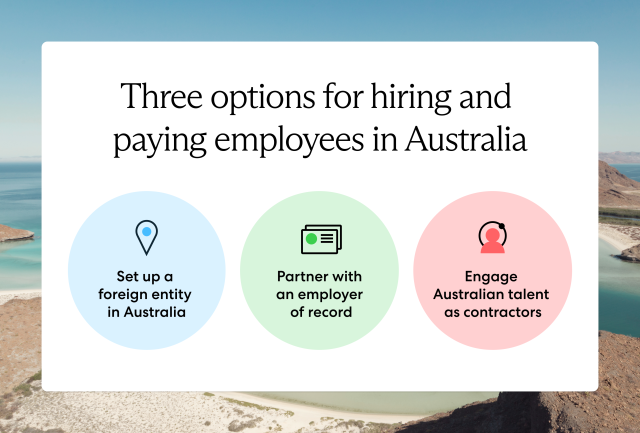Hiring employees in Australia is an excellent way for global companies to expand into the Asia Pacific Region (APAC). With a sound financial system, a stable government, and an advanced digital infrastructure, Australia offers businesses in any sector lucrative growth opportunities.
Still, hiring in Australia from abroad presents unique challenges. For instance, foreign HR teams face serious compliance risks navigating local employment regulations and corporate tax laws. Fortunately, building a distributed workforce in Australia doesn’t have to be overwhelming.
This guide explains how to quickly and compliantly hire employees in Australia from anywhere. Learn how to calculate total employee cost as you build an Australian workforce and discover the primary compliance risks global companies face in this market. Plus, find out how to hire Australian talent without setting up a local entity.
How do I hire staff in Australia?
To hire staff in Australia, global companies must establish a legal Australian business entity. If you don’t want to undergo incorporation, two simple workarounds are to partner with an employer of record (EOR) or engage Australian contractors. The best approach for your business depends on your budget and long-term plans for the Australian market.

Set up a legal entity in Australia
The traditional approach to hiring Australian talent from abroad is to set up a local business entity. The most common entities in Australia include the proprietary limited company (Pty Ltd), the limited liability partnership, and trusts.
With a legal entity, foreign businesses can establish an Australian branch and directly hire local talent. This approach reduces long-term employment costs and gives you complete control over hiring logistics, from hiring and onboarding to running global payroll. Plus, with a local business entity, you can more easily raise capital and further develop your business in Australia.
Still, entity establishment is costly and time-consuming. Incorporation involves a sizeable upfront investment and ongoing maintenance costs, and it takes several months of setup procedures before you can legally engage local talent. With a legal entity, you’re also responsible for ensuring compliance with local employment and tax regulations on your own.
Imagine a French software company wants to create a local branch office in Sydney. Depending on the business structure it chooses, total costs for entity establishment in Sydney can reach up to AU$30,000, including company incorporation, accounting, and government fees.
The company will also have ongoing obligations, from filing annual returns and lodging financial statements with the Australia Securities and Investments Commission (ASIC) to maintaining company details. The company’s degree of liability would also vary depending on its business structure—for example, subsidiaries are separate legal entities with limited liability, while branches aren’t.
Unless you are eyeing long-term expansion in the Australian market, entity establishment is often more trouble than it’s worth. For a more streamlined approach to hiring employees in Australia, consider partnering with an employer of record (EOR) instead.
Partner with an employer of record (EOR)
The simplest way to hire employees in Australia from abroad is to partner with an employer of record (EOR).
An EOR is a third-party entity with international legal expertise and access to global infrastructure that makes it easy for global companies to engage talent overseas without setting up legal entities or worrying about violating local employment regulations.
An EOR accelerates your expansion while decreasing risk exposure by offering localized support. For example, an EOR can craft region-specific benefits packages to ensure your company remains an attractive landing spot for top local talent. Plus, they offer ongoing HR support for your team, regardless of their time zone.
An EOR partner handles everything from hiring, onboarding, compliance, and immigration to running global payroll and administering global benefits. With an Australian EOR partner at your side, you can easily hire top Australian talent and build a global workforce without the added burden.
Learn more: What Is an Employer of Record (EOR)?
Engage contractors in Australia
A third option for engaging talent in Australia is to hire local contractors.
Many global companies find this approach attractive for its flexibility and cost savings. By engaging contractors, foreign employers can source talent with specialized skills for short-term projects while forgoing the costs of hiring, paying, and supporting a team of full-time employees.
However, hiring contractors limits your ability to establish a cohesive and committed team that can support further company growth. Plus, it exposes you to misclassification risk.
Misclassification occurs when a company classifies a worker as a contractor but establishes an employment relationship with them. In many cases, companies accidentally establish an employment relationship with their contractors and face severe penalties, such as employee back pay, fines, and injunctions.
We discuss misclassification in greater detail later on.
Learn more: Should You Hire a Contractor or an Employee?
How much does it cost to hire an employee in Australia?
The cost of hiring an employee in Australia is, at a minimum, 16-21% of the employee’s base salary. This is because the employer must contribute 11% to the Australian superannuation fund, as well as pay state taxes and worker’s compensation—both of which vary depending on the state or territory their employee lives in.
Interested in hiring employees in Australia? Use our employee cost calculator below to get reliable insights into employee costs and payroll contributions in Australia:
Superannuation fund
The superannuation fund is Australia’s public retirement program. This is an employer-only contribution that Australians refer to as a super guarantee (SG).
Australian labor law requires employers to pay an SG for almost all employees, with few exceptions. As of 2024, the SG rate equals 11% of the employee’s base salary up to AU$27,500. This rate will increase by one-half of a percentage point annually up to 12% by 2027.
Employees can make voluntary contributions to their superannuation fund at their own discretion.
State taxes
Previously a federally managed program, payroll taxes are now at the state level and are a significant part of an employer’s total payroll contributions. Payroll taxes cover infrastructure development and social welfare programs like education and healthcare.
Employers only pay state payroll taxes on employee wages above a certain annual threshold. Rates generally range from 4% to 6.85%, and thresholds range from AU$1 million to AU$2 million, depending on the state.
For instance, the state payroll tax rate in New South Wales is 5.45% on total annual taxable employee wages above AU$1.2 million. The contribution rate in the Australian Capital Territory is 6.85% on wages above AU$2 million.
Worker’s compensation insurance
All companies that hire employees in Australia must contribute to worker’s compensation insurance to cover employees for work-related accidents and illnesses.
Contribution rates vary between states and industries, ranging from roughly 0.3% to 14%. For instance, in South Australia, the contribution rate in dairy cattle farming is 6.6%, while in forestry it’s 2.9%. However, contribution rates in Victoria for the same industries are 6.1% and 3.8%, respectively.
In 2024, employer contributions to superannuation, state payroll taxes, and worker’s compensation insurance amount to roughly 16% to 21% of an employee’s gross salary.
Compliance risks when hiring employees in Australia
Compliance risks always arise when hiring internationally. Foreign employers unfamiliar with Australia’s local labor and tax regulations must perform due diligence when hiring talent in this market.
Common challenges global companies face while hiring in Australia include navigating local employment regulations, running compliant payroll, correctly classifying talent, understanding permanent establishment laws, and handling immigration procedures.
We discuss each of these in detail below and offer tips for mitigating risk.
Unfamiliar employment laws
One of the most challenging aspects of building a global workforce is navigating unfamiliar employment regulations in your target market. While some local regulations may reflect those in your home country, many aspects of Australian employment law will be unfamiliar.
For instance, the Fair Work Commission (FWC) reviews and sets the federal minimum wage annually, implementing changes on July 1. As of 2024, the current minimum wage in Australia is AU$23.23 per hour or AU$882.80 per 38-hour workweek. Probationary periods in Australia range from a few weeks to several months, and all employees receive 18 weeks of paid parental leave.
In addition to navigating federal employment and tax regulations, Global companies that hire employees in Australia must also familiarize themselves with varying state-level regulations.
For instance, Australian employers only withhold federal income taxes from employee earnings—states do not impose income taxes. However, payroll tax rates and worker’s compensation premiums vary drastically between states and industries, ranging from 0.3% to 14% of employee base earnings.
Ensuring ongoing compliance with local employment regulations at each level of government is critical for avoiding fines, limited business opportunities, and other penalties.
Incorrect payroll contributions
Running payroll for an international team is complex and involves unique risks. When hiring employees in Australia, global companies must navigate local payroll tax regulations, ensure correct withholdings, and use compliant payment methods to avoid fines, reputational damage, and employee churn.
Australian payroll taxes vary from those in many other countries. Federal income tax rates range from 0% to 45%, depending on an individual’s income bracket, and total employer contributions to statutory insurance programs amount to roughly 16% to 21% of the employee’s base monthly salary.
As previously mentioned, statutory contributions comprise the superannuation fund, state payroll taxes, and worker’s compensation. As of 2024, the superannuation rate is currently 11%. State payroll taxes range from 4% to 6.85%, and worker’s compensation ranges from 0.3% to 14%, depending on the state and industry.
Employers must calculate income tax and statutory contributions as percentages of their employees’ base earnings and remit payments to the Australian Taxation Office (ATO).
Running compliant global payroll is critical for ensuring timely, accurate payments to your Australian team. Consider mitigating risk by partnering with a third-party payroll provider, such as a global payroll partner.
Read also: Complete Guide to Payroll Tax: Definition, Costs, and Calculation
Misclassification
If you hire contractors instead of employees, you must be aware of the misclassification risk. Classification refers to how companies designate talent under local regulations—as contractors or employees.
While hiring international contractors comes with unique cost savings, it also comes with unique responsibilities.
Contractors don’t enjoy the range of employment rights that employees do, such as guaranteed health care, retirement insurance, and worker’s compensation. However, they enjoy unique freedoms, such as setting their work schedule, choosing their work attire, and subcontracting projects to other contractors.
Australian regulators have established worker classification regulations to prevent companies from hiring contractors for cost-savings while treating them like employees. These regulations are highly nuanced, consider multiple factors, and leave ample room for interpretation to determine the nature of a working relationship.
Consider the following example: a French software company engages remote talent in Australia on a contract basis and establishes daily work blocks during which the contractors must be online and available to the domestic team.
By controlling its contractors’ work schedule, the company establishes an employment relationship under local classification regulations and subjects itself to fines, back taxes, benefits arrears, and other penalties.
If you hire Australian contractors, be sure to enlist a qualified HR team and provide them with the necessary resources to stay abreast of workplace dynamics and legislation changes.
Read more in our complete guide to employee misclassification.
Permanent establishment
If a foreign company’s business operations trigger permanent establishment (PE) status in its target market, it faces local corporate taxation.
In most countries, a PE is any foreign entity that performs ongoing, income-generating operations in the local market from a fixed place of business. However, each country defines a fixed place of business differently.
Australian domestic law defines a PE as any person or entity that conducts business in the country under the following circumstances:
- Selling goods from a physical location that another person or entity manufactured, assembled, processed, packed, or distributed while either party participates in the other’s management or capital
- Installing and using substantial equipment at a physical location
- Engaging in a construction contract
- Hiring a local agent who habitually exercises the authority to negotiate and conclude contracts on the company’s behalf
Remember, double tax agreements (DTAs) also determine PE status in Australia. Australia has DTAs with over 40 countries to prevent double taxation and fiscal evasion and help each country’s tax authorities enforce their respective tax laws.
Most DTAs define PEs similarly to domestic laws; however, DTAs often override domestic law. Foreign employers operating in the Australian market must familiarize themselves with relevant DTAs between their home country and Australia to ensure compliance.
Read also: Permanent Establishment Checklist for Global Companies.
Immigration requirements
As you build an Australian workforce, you may need to hire a foreign national in Australia who doesn’t hold a local residence permit or work visa. Or, as a part of your global mobility offering, you may need to relocate a domestic employee to Australia.
In either case, you’ll need an experienced HR team that can swiftly navigate Australian immigration procedures, allowing you to hire and relocate talent as needed while avoiding operational delays.
Consider the following example: a highly-valued employee working for a British software company wants to relocate from the U.K. to Australia.
The company has invested significant time and resources into this employee, and he has a highly coveted skillset. Plus, the company is currently developing a new product. The business recognizes the value of supporting his relocation and must act fast.
By quickly navigating immigration procedures, offering comprehensive relocation support, and swiftly incorporating him into the company’s Australian payroll after onboarding, the employer avoids operational delays and prevents the employee from seeking other job opportunities.
Immigration procedures often place a burden on HR and legal teams. Global companies hiring talent in Australia should consider partnering with a local immigration expert, such as an EOR, to streamline visa application and relocation processes and ensure compliance.
Hiring employees in Australia: FAQ
Below, you can find answers to commonly asked questions about hiring employees in Australia.
Can a U.S. company employ someone in Australia?
Yes, U.S. companies can employ people residing in Australia. By establishing an Australian business entity, partnering with an employer of record (EOR), or engaging contractors, U.S. companies can hire Australian talent from abroad and enjoy the many lucrative business opportunities this market has to offer.
Can a U.S. company hire an Australian employee with an E3 visa?
Yes, a U.S. company can hire an Australian employee with an E-3 visa. To hire Australian talent under the E-3 visa program, the employer must first acquire Labor Condition Application (LCA) certification from the U.S. Department of Labor (DOL). The employee can then apply for the E-3 visa directly at a U.S. Embassy or Consulate abroad.
An E-3 visa is a U.S. work visa that allows highly skilled Australians to live and work in the U.S. The E-3 visa is available only to professionals with a qualifying university degree and relevant experience in a specialty role. Examples of specialty roles include software developers, architects, and engineers.
The E-3 visa application process is costly and time-consuming. It requires numerous documents, such as Form ETA-9035, proof of the employee’s qualifications, a copy of the job offer, and a copy of the original job posting. Collecting required documents and ensuring ongoing compliance can burden HR teams.
If you’re interested in hiring Australian talent on the E-3 visa, consider partnering with a global immigration expert, such as an EOR. An EOR streamlines all aspects of hiring Australian employees and relocating them to the U.S., from sourcing top local talent and handling visa and immigration procedures to providing relocation support on your behalf.
Read also: Understanding the E3 Visa: Guide for U.S. Employers
Hiring employees in Australia is simple with Velocity Global
Hiring employees in Australia offers global companies a wealth of opportunities. However, engaging talent overseas involves unique risks. Eliminate the risk and simplify your hiring efforts by partnering with Velocity Global.
Velocity Global’s EOR solution takes the complexity and guesswork out of building international teams. We make it easy for global companies to hire talent in more than 185 countries, including Australia, without undergoing entity establishment or worrying about compliance.
We can serve as your global HR team, handling everything from hiring, onboarding, immigration, and compliance to running global payroll, administering global benefits, and offering ongoing HR support for your Australian workforce on your behalf.
With Velocity Global at your side, you can source top local talent and build your dream team in Australia with ease—contact us today to get started.



